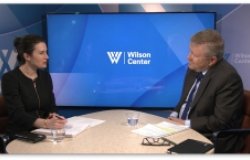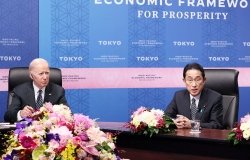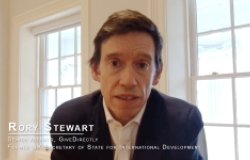Book Launch -- <i>The Regional Roots of Developmental Politics in India: A Divided Leviathan</i>
With author Aseema Sinha, Woodrow Wilson Center Fellow and Assistant Professor, University of Wisconsin, Madison; and commentator Ambassador Teresita C. Schaffer, Director, South Asia Program, CSIS
Overview
The Regional Roots of Developmental Politics in India: A Divided Leviathan
June 8, 2005
With author Aseema Sinha, Woodrow Wilson Center Fellow and Assistant Professor at the University of Wisconsin, Madison
And commentator:
Ambassador Teresita C. Schaffer, Director, South Asia Program, CSIS
The Wilson Center's Program on Science, Technology, America, and the Global Economy in partnership with the Center's Asia Program hosted a discussion of Wilson Center Fellow Assema Sinha's just published volume, The Regional Roots of Developmental Politics in India: A Divided Leviathan. Sinha is an Assistant Professor of Political Science at the Univesity of Wisconsin, Madison.
Teresita C. Schaffer, former Ambassador to Sri Lanka and former Deputy Assistant Secretary of State for South Asia, provided commentary.
Assema Sinha noted that India before 1991 was often referred to as a failed developmental state. Sinah departs from the usual focus on the national government and national policies to emphasize the importance of state and provincial governments. In her view, the national development trajectory is the result of national and provincial interaction and how states actually implement national directives and plans.
In exploring the dynamics of national-state interaction, Sinah focuses on three large Indian states, Gujarat (50 million in population), Tamil Nadu (62 million), and West Bengal (80 million). In terms of population, all would be good sized to large European countries.
Sinha posed two key questions: Why are some states better than others given the same constraints imposed by the central state? What distinguished high performing from less successful states?
To answer her questions, Sinha worked to open the 'black box' of the individual states to see how the actual system worked. She noted that India was not uniformly centrist. While applications to establish a new plant required a permit from the Ministry of Industry, the clearances for land and power depended on state action. States that approved more of their licenses attracted more investment.
In their dealings with the national government, the states had a variety of veto and choice points in the License Raj that created opportunities to lobby the national government. How did the individual states respond to these possibilities? Sinah found that micro institutions mattered. How much credibility did the state have in terms of the certainty of regulation? How much coordination was there across agencies? How available was information on exports and other economic matters? In sum, successful states compensated for public sector as well as market failures. In the post-1991 reform period, multiple ministries offer many more opportunities for state initiatives.
Ambassador Schaffer offered four observations and then speculated about what emerging trends might portend for the future. First, she emphasized that the central state makes macroeconomic policies. Second, she agreed with Sinha that the quality of state and local government mattered. Third, there was a fiscal side to decentralization with individual states accounting for roughly half of India's fiscal deficit. Fourth, personalities and pioneers mattered. Leaders and determined entrepreneurs could both influence the course of events. Development in the world of information technology created new, largely unregulated opportunities. Rushing to seize them, what Schaeffer terms pioneers have vaulted to national prominence. Schaffer also commented on how the pioneers were geographically concentrated – what many economists refer to as clusters or poles of development.
Then, Schaffer turned her attention to the future. She did not see political decentralization following in the wake of decentralized economic developments. But she speculated that a new political class could emerge out of the pioneers. Some younger parliamentarians already emphasized a good government model and a tech influenced orientation. Schaffer also noted the shifting balance between national and state parties with the state parties gaining in influence. She expressed some concern that the geographic concentration of rising incomes was also having an impact on vertical income distribution.
During the discussion period, Sinha fielded questions that ranged from the ability of states to provide infrastructure, the changing role of personality, and the presence or absence of corruption. Sinha noted that infrastructure did vary by state and pointed to the success of Gujarat in securing an infrastructure loan from the Asian Development Bank. To a question on the role of caste, she responded the importance of descent varied according to the politics of each state. Personality still counted. She thought it was too early to judge whether or not a new political class was emerging. Corruption was everywhere but in more successful states the corruption "premium" was smaller and "bought" more reliable results.
Prepared by Kent Hughes, Director, Program on Science, Technology, America, and the Global Economy Ext. 4312
Hosted By

Indo-Pacific Program
The Indo-Pacific Program promotes policy debate and intellectual discussions on US interests in the Asia-Pacific as well as political, economic, security, and social issues relating to the world’s most populous and economically dynamic region. Read more
Thank you for your interest in this event. Please send any feedback or questions to our Events staff.










